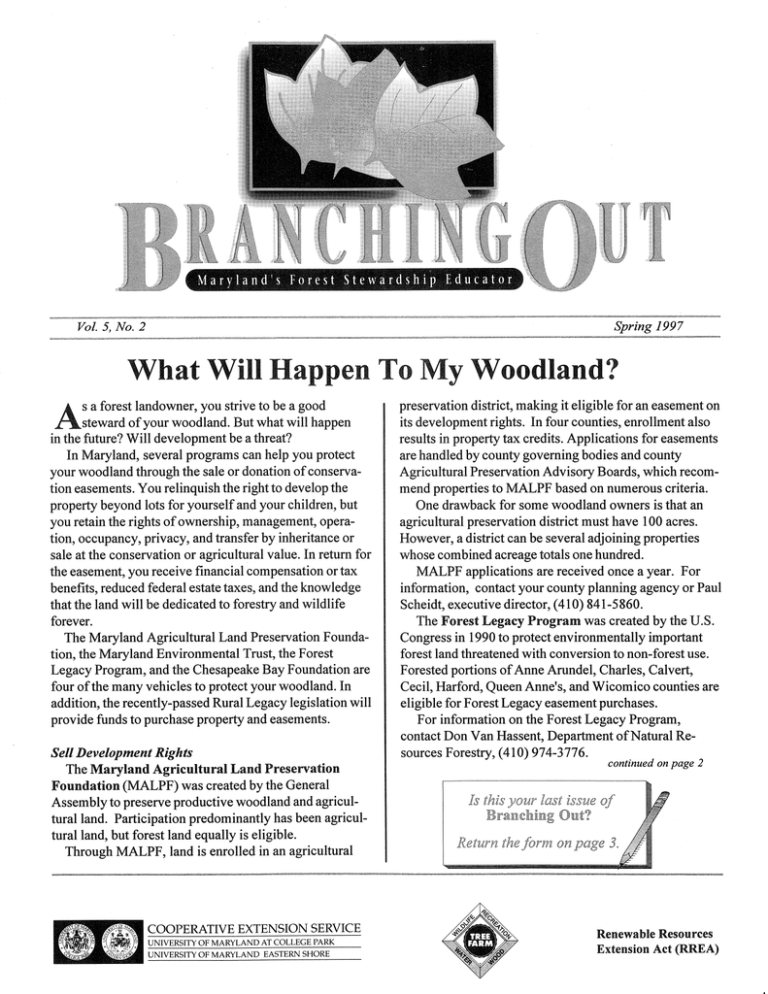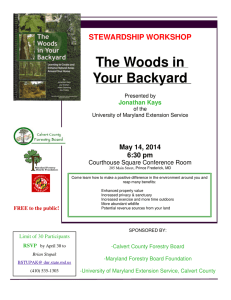A What Will Happen To My Woodland?
advertisement

Maryland's Forest Stewardship Educator Spring 1997 Vol. 5, No.2 What Will Happen To My Woodland? A s a forest landowner, you strive to be a good steward of your woodland. But what will happen in the future? Will development be a threat? In Maryland, several programs can help you protect your woodland through the sale or donation of conservation easements. You relinquish the right to develop the property beyond lots for yourself and your children, but you retain the rights of ownership, management, operation, occupancy, privacy, and transfer by inheritance or sale at the conservation or agricultural value. In return for the easement, you receive financial compensation or tax benefits, reduced federal estate taxes, and the knowledge that the land will be dedicated to forestry and wildlife forever. The Maryland Agricultural Land Preservation F oundation, the Maryland Environmental Trust, the Forest Legacy Program, and the Chesapeake Bay Foundation are four of the many vehicles to protect your woodland. In addition, the recently-passed Rural Legacy legislation will provide funds to purchase property and easements. Sell Development Rights The Maryland Agricultural Land Preservation Foundation (MALPF) was created by the General Assembly to preserve productive woodland and agriculturalland. Participation predominantly has been agriculturalland, but forest land equally is eligible. Through MALPF, land is enrolled in an agricultural COOPERATIVE EXTENSION SERVICE UNIVERSITY OF MARYLAND AT COLLEGE PARK UNIVERSITY OF MARYLAND EASTERN SHORE preservation district, making it eligible for an easement on its development rights. In four counties, enrollment also results in property tax credits. Applications for easements are handled by county governing bodies and county Agricultural Preservation Advisory Boards, which recommend properties to MALPF based on numerous criteria. One drawback for some woodland owners is that an agricultural preservation district must have 100 acres. However, a district can be several adjoining properties whose combined acreage totals one hundred. MALPF applications are received once a year. For information, contact your county planning agency or Paul Scheidt, executive director, (410) 841-5860. The Forest Legacy Program was created by the U.S. Congress in 1990 to protect environmentally important forest land threatened with conversion to non-forest use. Forested portions of Anne Arundel, Charles, Calvert, Cecil, Harford, Queen Anne's, and Wicomico counties are eligible for Forest Legacy easement purchases. For information on the Forest Legacy Program, contact Don Van Hassent, Department of Natural Resources Forestry, (410) 974-3776. continued on page 2 Is this your last issue of Branching Out? Return the form on page 3. Renewable Resources Extension Act (RREA) Donate a Conservation Easement The woodland owner who prefets an income tax break to income can donate land to the Chesapeake Bay Foundation, the Maryland Environmental Trust, or one ofthe 40 local land trusts in Maryland. The Maryland Environmental Trust (MET) was created by the General Assembly to protect Maryland's natural environment through voluntary cooperative programs. Forest and farm land, wildlife habitat, historic sites, and properties with scenic features are eligible. MET works closely with the local land trusts, often directing property owners to those programs or obtaining easements jointly. Landowners deal directly with MET, which evaluates each offer on a rolling application basis. For details on MET, contact Nick Williams, (410) 514-7900. Landowners who prefer a private, non-profit organization, can work with the Chesapeake Bay Foundation. The Foundation primarily helps match landowners with a local land trust; however, it does hold donated conservation easements on several thousand acres in the Chesapeake Bay watershed, which includes most of Maryland. For details on CBF, contact Lee Epstein, (410) 268-8816. Selling or donating a conservation easement through the above programs dedicates your land to the forestry and wildlife practices you have managed. ALERT! Will RREA Continue? On the front of this newsletter is "Renewable Resources Extension Act (RREA)." What is RREA? RREA is part of the Farm Bill and has provided for "an expanded and comprehensive Extension program for forest and rangeland renewable resources," including programs on urban forestry and environmental education. RREA is the mainstay for Extension education in support ofthe nation's forest, wildlife, and wetlands resources. In Maryland, these funds pay for the printing, mailing, and staff necessary to produce Branching Out. They also support the forest and wildlife volunteer program, the Coverts Project, stewardship workshops, the natural resources income opportunities programs, and other educational efforts. The proposed President's budget for 1998 deletes all funding for RREA and would greatly reduce these education efforts in Maryland. .. page 2 Update on Forest Health Gypsy moths continue to be a problem in southern Maryland in Charles and Prince George's counties and on the Eastern Shore in Dorchester, Somerset, Talbot, Wicomico, and Worcester counties. Other sections of Maryland have seen a decline in gypsy moth populations and no spraying is proposed there. The favored host of gypsy moths is oaks. Defoliation by forest tent caterpillars could be high this year, based on the sampling of areas defoliated in 1996. These areas mostly were in bottomland forests along creek and river drainage, particularly the Pocomoke River and its tributaries. Historically, outbreaks offorest tent caterpillars have lasted several years in Maryland. Forest tent caterpillars favor aspen, black gum, sweet gum, sugar maple, and oaks. Species not affected are red maple, sycamore, and most conifers. Elm yellows disease is in Maryland. Trees do not recover from elm yellows, nor is there any treatment available currently. Areas affected center around the Interstate-81 and -70 corridors in Allegany, Frederick, and Washington counties. Elms are affected rapidly and dramatically. In mid to late summer, leaves tum yellow and drop, roots become damaged severely, and the tree dies. Elms most susceptible are American, cedar, red, and September. For information on the forest pests mentioned above, contact the Maryland Department of Agriculture's Forest Pest Management section, (410) 841-5922. The following web sites have information on Maryland's forests and forest pests: http://www.mda.state.md.us; http:// gacc.com/dnr/forestslPublicationslHealthrptlindex.html; and http://troy2.fs1.wvnet.edu. .. Two Statewide Associations Serve Maryland Forestry Interests Two associations, the Maryland Forests Association and the Association of Forest Industries, Inc., serve forest interests in Maryland. Maryland Forests Association The Maryland Forests Association, founded in 1976, is a nonprofit citizen's organization for those interested in trees, forests, and forestry. Its mission is "to promote the maintenance of a healthy and productive forest land base to enhance the economic, environmental, and social well-being of all who live in the State. " Serving as an advocate for individual forest landowners, natural resources professionals, the forest industry, and others in both private and public sectors of the forest community, MFA works on existing problems and identifies new concerns. MFA sponsors educational programs and events, including the Maryland Master Logger Program, Logger! Forestry Field Days and Equipment Expos, forestry tours, an annual meeting, and programs for youth through Project Learning Tree, 4-H, and Envirothon. It cooperates with other forestry groups' educational and promotional efforts, provides educational information to individuals and groups, and testifies on forestry issues before local and state officials and legislators. A quarterly newsletter, The Crosscut, serves its 500 members and others. During the Maryland General Assembly session, MFA produces Legislative Updates, with information on pending legislation and recommended positions. MFA is governed by officers and an elected board of directors. Contact Karin Miller, MFA administrator, (301) 895-5369. foresters. It was founded in fall 1996 to protect and promote the forest industry. Its mission is "to effect ongoing oversight of the State/ local governmental statutory and regulatory process; strengthen the partnership with affiliate organizations; initiate ideas that bolster the stature and promote the interests ofMaryland 'sforest industry; and educate the citizenry about the economic, environmental, and social benefits accruing via professional forestry conservation/ management. " API has focused on several issues in the Maryland General Assembly. It is pursuing a revision of the economic impact ofthe forest industry on Maryland's economy; a special for Maryland Public Television; and studies of the effect on the forest industry of state truck load limits, worker compensation, and taxes. API will "advise and assist any forest-related industry or forest landowner concerned about protecting the 'bottom line' and property rights from increased governmental interference." It is governed by officers, with two regional vice presidents. Contact AFI President H. Edward Yates, (301) 8702110, or AFI Executive Director William R. Miles, (410) ~ 414-2515. Association of Forest Industries The Association of Forest Industries, Inc. represents Maryland's sawmills, secondary processing companies, forest landowners, loggers, and professional consulting -----------------------------------. ~ Is this your last issue? To reduce costs and waste, we must limit the distribution of Branching Out. Ifthere is an "F" to the right of your name on the mailing label, we have no record that you want to continue receiving Branching Out. To stay on the list or correct your address, return this form to the Branching Out address on the reverse side. Ifthere is a "T" on your mailing label, you're on the list for future issues. Check one: landowner natural resources professional other (explain) page 3 • ·# How to Produce and Market Paulownia, Bulletin 319: New 22-page publication. Help!! landowners decide whether to grow paulownia, a wood in demand in international markets but relatively new to American woodlots. Includes details on paulownia history, species characteristics, wood properties, products, distribution, site selection and preparation, seed and stock selection, planting, intercropping, maintenance, and marketing. Also discusses the economics of paulownia production and cost-sharing programs. Lists other paulownia publications. Loaded with charts and photographs. $2, from your local Cooperative Extension Service office. Maryland Hardwood Defoliators: Spring Caterpillars, MDA 144-3: New forest pest leaflet. Available from the Maryland Department of Agriculture, (410) 841-5922. Riparian Forest Buffers--The Link Between Land & Water: Attractive and interesting new video explains and illustrates the functions and values of the riparian forest habitat. Designed for landowners, it is appropriate for individual or group viewing. 21 minutes; closed-captioned. Borrow from your MD, P A, or VA local Cooperative Extension Service office, state forest and wildlife agency, or Natural Resources Conservation Service, or purchase for $15 from the Wye Research and Education Center, (401) 827-8056. Sources of Information and Guidance for Forest Stewards, Fact Sheet 624: Revised bulletin of resources Hunting Lease Liability Insurance: Information bro- for forest owners from county, state, and federal agencies and private organizations. Contact your local Cooperative Extension Service office. chure and application for membership and insurance for the landowner who leases land for hunting. Forest Landowners Association, 1-800-325-2954. .. Non--P!'<'c,fi t BRANCHING OUT Maryland Cooperative Extension Service 18330 Keedysville Road Keedysville, MD 21756 Vol. 5, No.2-Spring 1997 Is this your last issue? See the form on page 3. U.S;r Dr<·,]. POE.ta~:J€' PAID
